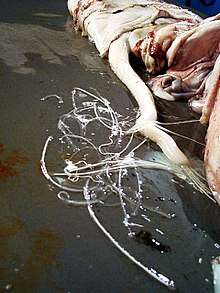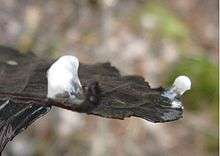Spermatophore
A spermatophore or sperm ampulla is a capsule or mass containing spermatozoa created by males of various animal species, especially salamanders and arthropods, and transferred in entirety to the female's ovipore during reproduction. Spermatophores may additionally contain nourishment for the female, in which case it is called a nuptial gift, as in the instance of bush crickets.[1][2] In the case of the toxic moth Utetheisa ornatrix, the spermatophore includes sperm, nutrients, and pyrrolizidine alkaloids which prevent predation because it is poisonous to most organisms.[3] However, in some species such as the Edith's checkerspot butterfly, the "gift" provides little nutrient value. The spermatophore transferred at mating has little effect on female reproductive output.[4] The alternative hypothesis of its usefulness is that the process of eating the spermatophore prevents the female from subsequent copulation, serving as a mating plug, thereby giving the male's sperm more time to fertilize. In some cephalopods, however, spermatophores from multiple males might be present inside the same female simultaneously.[5]


Invertebrates
Spermatophores are the norm in arachnids and several soil arthropods. In various insects, such as bush crickets, the spermatophore is often surrounded by a proteinaceous spermatophylax. The function of the spermatophylax is to cause the female to relinquish some of her control over the insemination process allowing full sperm transfer from the spermatophore.[6] Some species of butterflies and moths also deposit a spermatophore into the female during copulation. Examples include the speckled wood butterfly[7] or the ornate moth, where males invest up to 10% of their body mass in creating a single spermatophore.[8] Malaysian stalk-eyed flies also deposit a spermatophore into the female during copulation, but the spermatophore is very small in size and occupies only part of the female's vaginal capacity. This is likely an adaptation to the tendency towards high mating frequency in this species.[9] These butterfly species have been known to use mud-puddling behavior, as demonstrated by Dryas iulia, to obtain the minerals needed in spermatophore production.[10] In some cephalopods, like the argonaut octopus, the spermatophors are contained in a detachable arm capable of autonomous movement and prolonged survival inside the female, to the point that it was mistaken for a parasitic worm by George Cuvier, who gave it the generic name of Hectocotylus.
Vertebrates
Some vertebrates also reproduce via spermatophores. Males of most salamander and newt species create spermatophores, which the females may choose to take up or not, depending on the success of the male's mating display.[11]
References
- Nina Wedell, Tom Tregenza & Leigh W. Simmons (2008), "Nuptial gifts fail to resolve a sexual conflict in an insect", BMC Evolutionary Biology, 8: 204, doi:10.1186/1471-2148-8-204, PMC 2491630, PMID 18627603
- Peter D. Sozou & Robert M. Seymour (2005), "Costly but worthless gifts facilitate courtship", Proceedings of the Royal Society B, 272 (1575): 1877–1884, doi:10.1098/rspb.2005.3152, PMC 1559891, PMID 16191592
- Gonzalez, A.; Rossini, C.; Eisner, M.; Eisner, T. (1999). "Sexually transmitted chemical defense in a moth (Utetheisa ornatrix)". Proceedings of the National Academy of Sciences USA. 96 (10): 5570–5574. doi:10.1073/pnas.96.10.5570. PMC 21901. PMID 10318925.
- Jones; Odendaal, Ehrlich (January 1986). "Evidence against the spermatophore as paternal investment in checkerspot butterflies (Euphydras: Nymphalidae)". American Midland Naturalist. 116 (1): 1–6. doi:10.2307/2425932. JSTOR 2425932.
- Marah J. Hardt, Sex in the Sea: Our Intimate Connection with Sex-Changing Fish, Romantic Lobsters, Kinky Squid, and Other Salty Erotica of the Deep
- K. Vahed (1998), "The function of nuptial feeding in insects: review of empirical studies" (PDF), Biological Reviews, 73: 43–78, doi:10.1111/j.1469-185X.1997.tb00025.x, archived from the original (PDF) on 2012-03-11
- Svärd, L. (1985). "Paternal investment in a monandrous butterfly, Pararge aegeria". Oikos. 45 (1): 66–70. doi:10.2307/3565223. JSTOR 3565223.
- Iyengar, Vikram K.; Thomas Eisner (1999). "Female choice increases offspring fitness in an arctiid moth (Utetheisa ornatrix)". Proceedings of the National Academy of Sciences USA. 96 (26): 15013–15016. doi:10.1073/pnas.96.26.15013. PMC 24764. PMID 10611329.
- Kotrba, Marion (1996-07-01). "Sperm transfer by spermatophore in Diptera: new results from the Diopsidae". Zoological Journal of the Linnean Society. 117 (3): 305–323. doi:10.1111/j.1096-3642.1996.tb02192.x. ISSN 0024-4082.
- Beck, Jan; Mühlenberg, Eva; Fiedler, Konrad (1999-04-01). "Mud-puddling behavior in tropical butterflies: in search of proteins or minerals?". Oecologia. 119 (1): 140–148. doi:10.1007/s004420050770. ISSN 0029-8549. PMID 28308154.
- Wells, Kentwood D. (2007). "The Natural History of Amphibian Reproduction". The Ecology & Behavior of Amphibians. Chicago: University of Chicago Press. pp. 451–515. ISBN 9780226893334.